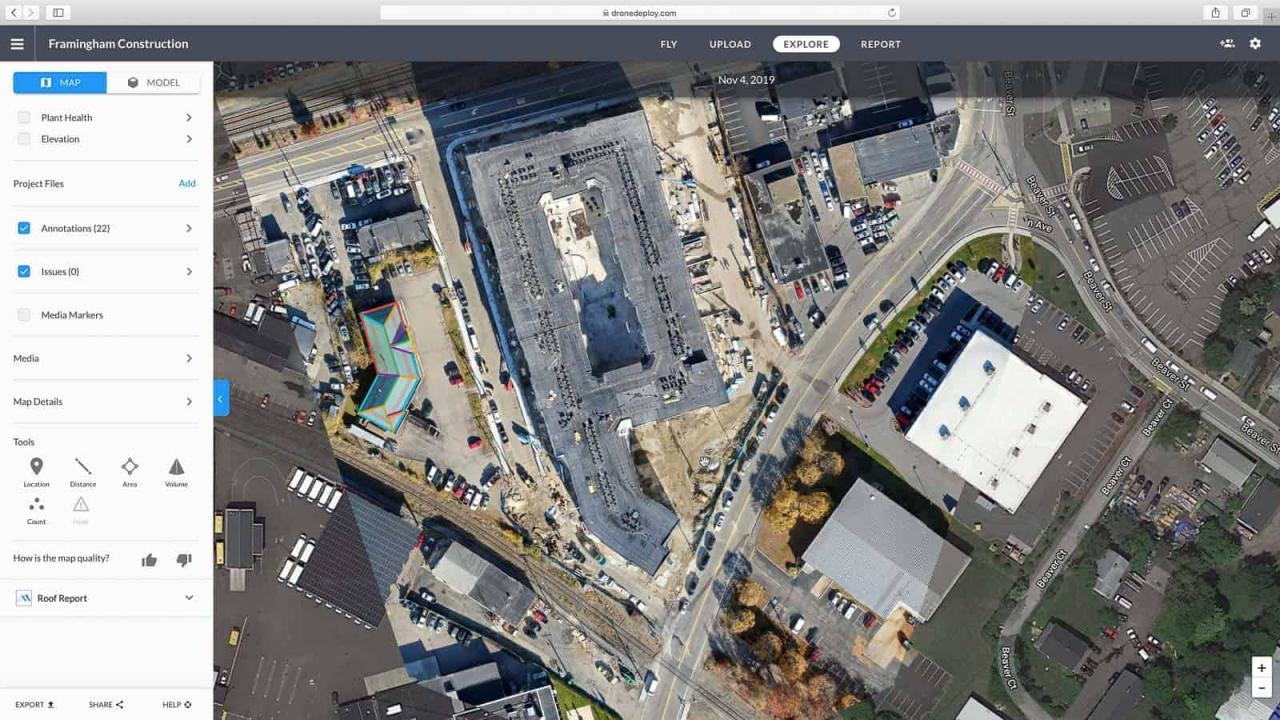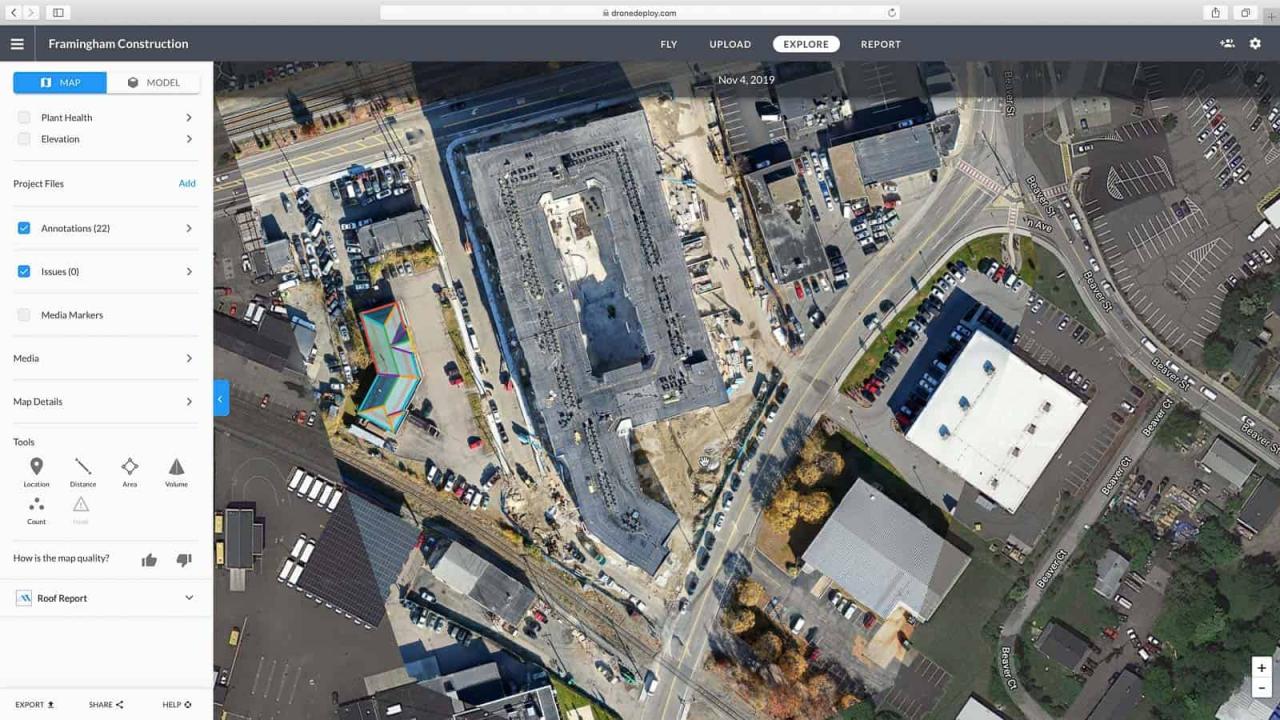How to use drone deploy – How to use DroneDeploy? It’s easier than you think! This guide walks you through everything from setting up your account and planning flights to processing data and generating professional reports. We’ll cover the basics, explore advanced features, and troubleshoot common issues, making drone surveying accessible to everyone, regardless of your experience level. Get ready to take your data collection to new heights!
DroneDeploy simplifies the entire drone workflow, from pre-flight planning to post-flight analysis. You’ll learn how to leverage its powerful tools to capture high-quality aerial imagery, process it efficiently, and extract valuable insights for various applications. We’ll demystify the process, providing clear, step-by-step instructions and practical tips along the way.
Getting Started with DroneDeploy
DroneDeploy is a powerful cloud-based platform that simplifies the entire drone workflow, from flight planning to data analysis. This guide will walk you through the essential steps to get started and leverage its capabilities effectively.
Creating a DroneDeploy Account
Setting up your DroneDeploy account is straightforward. Navigate to the DroneDeploy website and click on “Sign Up.” You’ll need to provide your email address, create a password, and choose a plan that suits your needs. After registration, check your email for a verification link to activate your account. Ensure your email address is accurate to receive important notifications and updates.
Importing or Creating a Site Map
Once logged in, you can begin creating or importing your project site map. This is the foundational step for all your drone operations. To import a site map, simply upload a compatible file (e.g., KML, Shapefile). To create a new site map, use the platform’s drawing tools to Artikel the area you intend to survey. Accurate site mapping ensures efficient flight planning and data processing.
Planning Your Drone Flight
Effective flight planning is crucial for efficient data acquisition. DroneDeploy provides intuitive tools to design your flight plan, optimizing for factors such as battery life, image overlap, and altitude.
Designing a Flight Plan
Within the DroneDeploy platform, define your site’s boundaries and choose the desired flight parameters. The platform automatically calculates the optimal flight path, considering factors like battery life, ensuring complete coverage and sufficient image overlap for accurate data processing. Adjust altitude and camera settings based on the required level of detail and ground resolution. Remember to account for wind conditions and other environmental factors that may affect flight stability.
Pre-flight Checklists and Safety Procedures
Before each flight, it’s essential to perform a thorough pre-flight checklist. This includes verifying battery levels, checking the drone’s functionality, confirming GPS signal strength, and ensuring a safe flight environment free from obstacles and hazards. Adherence to all relevant aviation regulations and safety guidelines is paramount.
Camera Settings for Optimal Results
Selecting the appropriate camera settings is critical for achieving high-quality data. Resolution should be chosen based on the required level of detail. Higher resolution results in larger data files but provides greater accuracy. ISO settings should be adjusted according to lighting conditions; lower ISO values are generally preferred in bright light to minimize noise. Experimentation and understanding of your drone’s camera capabilities are key to optimal settings.
Executing the Drone Flight

Once your flight plan is finalized and pre-flight checks are complete, you can initiate the drone flight through DroneDeploy.
Connecting Your Drone and Initiating Flight
Connect your compatible drone to the DroneDeploy app, following the app’s instructions. Once connected, initiate the automated flight plan. The drone will autonomously follow the planned flight path, capturing images at pre-defined intervals. Monitor the flight progress on your device. Real-time feedback and alerts will help you ensure smooth operation.
Troubleshooting Common Flight Issues
During flight operations, unexpected issues may arise. Common problems include GPS signal loss, low battery warnings, and unexpected wind conditions. DroneDeploy provides in-app alerts and troubleshooting guidance. Understanding these potential problems and having contingency plans in place will help ensure successful data acquisition. In case of a significant issue, prioritize safe landing procedures.
Handling Unexpected Events
In case of unexpected events such as low battery or signal loss, the drone is typically programmed to initiate a return-to-home (RTH) procedure. However, always remain vigilant and be prepared to take manual control if necessary, prioritizing safety and responsible operation.
Processing and Analyzing Drone Data
DroneDeploy offers various data processing options to transform raw images into valuable insights.
Data Processing Options
After your drone flight is complete, upload the captured imagery to the DroneDeploy platform. The platform offers different processing options, including orthomosaic creation, 3D model generation, and point cloud extraction. Choose the option that best suits your needs and project requirements. Processing times vary depending on data size and selected options.
Comparison of Processing Outputs
An orthomosaic is a georeferenced mosaic of images, providing a high-resolution, 2D representation of the area surveyed. A 3D model creates a three-dimensional representation of the terrain, ideal for volume calculations and terrain analysis. A point cloud is a collection of individual 3D points, useful for detailed measurements and precise modeling.
Typical Processing Times
Processing times are highly variable, depending on the data size and chosen processing options. Larger datasets naturally require longer processing times. Faster processing options may be available at an additional cost.
| Data Size (GB) | Processing Option | Processing Time (approx.) | Notes |
|---|---|---|---|
| 1-2 | Orthomosaic | 30-60 minutes | Faster processing with fewer images |
| 5-10 | 3D Model (low resolution) | 2-4 hours | Higher resolution models take significantly longer |
| 10-20 | Point Cloud & Orthomosaic | 6-12 hours | Complex processing requiring significant computing power |
| >20 | All options | 12+ hours | Consider splitting the data into smaller sections for faster processing |
Interpreting Data and Generating Reports
The processed data provides valuable insights that can be used for various applications.
Key Features and Measurements
From the processed data, you can extract various key features and measurements, such as area calculations, volume estimations, height measurements, and distance calculations. The specific features you extract depend on your project’s goals. DroneDeploy’s tools facilitate these measurements, allowing for precise and accurate data extraction.
Workflow for Extracting Relevant Information
A typical workflow involves first identifying the required measurements and then using DroneDeploy’s measurement tools to extract them. For volume calculations, for example, you would define the boundaries of the area and let the software calculate the volume. Progress tracking involves comparing data from multiple flights to identify changes over time.
Creating Professional Reports
DroneDeploy allows for the creation of professional-looking reports by incorporating data visualizations such as orthomosaics, 3D models, and charts. These reports can be customized with annotations, measurements, and other relevant information. The platform offers export options for sharing reports in various formats.
Advanced DroneDeploy Features: How To Use Drone Deploy
DroneDeploy offers advanced features to enhance data analysis and unlock further capabilities.
Thermal Imaging Integration and 3D Modeling Enhancements

DroneDeploy supports integration with thermal cameras, allowing for the detection of temperature variations. This is valuable in various applications, such as building inspections, infrastructure monitoring, and agriculture. Advanced 3D modeling features enable the creation of highly detailed and accurate 3D models, ideal for complex projects requiring precise measurements and visualizations.
Industry Applications of Advanced Features
Thermal imaging is used in construction to identify areas of heat loss in buildings, improving energy efficiency. In agriculture, thermal imaging can help identify stressed plants or irrigation issues. High-resolution 3D models are valuable in mining for accurate volume calculations and stockpile management.
Using a Specific Advanced Feature: Creating a 3D Model
To create a high-resolution 3D model, select the “3D Model” processing option after uploading your data. Choose the desired level of detail and processing parameters. The platform will then generate a detailed 3D model that can be rotated, zoomed, and measured. This model can be exported in various formats for use in other software.
Getting started with DroneDeploy is easier than you think! First, you’ll want to familiarize yourself with the software’s interface and key features. Then, check out this awesome tutorial on how to use DroneDeploy to learn the ropes. After that, practice flying your drone and processing the data; you’ll be creating professional-looking maps in no time!
Troubleshooting and Support
Despite the user-friendly nature of DroneDeploy, occasional issues may arise.
Common Errors and Solutions
Common errors include issues with uploading data, processing failures, and problems with flight planning. DroneDeploy’s help center provides detailed troubleshooting guides for these and other common problems. Many issues can be resolved by reviewing the platform’s documentation or contacting support.
Resources for Technical Support

DroneDeploy offers various support channels, including online help documentation, FAQs, and direct support via email or phone. The community forum provides a platform for users to share experiences and solutions.
Common Questions and Answers
- Q: My drone lost connection during flight. What should I do? A: Most drones have a return-to-home (RTH) function. If the drone doesn’t automatically return, attempt to regain control. If unsuccessful, contact local authorities if necessary.
- Q: My data processing is taking a long time. Is this normal? A: Processing time depends on data size and selected options. Larger datasets take longer. Consider splitting large datasets into smaller chunks for faster processing.
- Q: I’m having trouble uploading my flight data. What should I check? A: Ensure you have a stable internet connection. Check the file format and size of your data to ensure compatibility with DroneDeploy. Contact support if issues persist.
Illustrative Examples
Here are two examples illustrating the use of DroneDeploy in different industries.
Construction Site Monitoring
A construction company used DroneDeploy to monitor progress on a large-scale building project. They collected high-resolution images of the site at regular intervals. The resulting orthomosaic showed the building’s progress over time, allowing for accurate volume calculations of materials used and identification of potential delays. The orthomosaic clearly displayed the foundation, structural elements, and completed sections of the building, highlighting progress and identifying any discrepancies from the planned design.
Agriculture, How to use drone deploy
A farmer used DroneDeploy to assess the health of their crops. They captured imagery using a multispectral camera. The resulting NDVI (Normalized Difference Vegetation Index) map showed areas of healthy vegetation in green and areas of stress in red. This allowed the farmer to identify areas needing additional irrigation or fertilization. The NDVI map clearly highlighted areas of healthy, vigorous growth and those suffering from nutrient deficiency or water stress, enabling targeted interventions to optimize crop yields.
Mastering DroneDeploy opens up a world of possibilities for efficient and accurate data collection. From construction site monitoring to precision agriculture, the applications are vast. By following this guide, you’ve gained the knowledge and skills to confidently utilize DroneDeploy’s features, maximizing the potential of your drone program and extracting meaningful insights from your aerial data. Now go forth and fly!
FAQ Section
What types of drones are compatible with DroneDeploy?
DroneDeploy supports a wide range of drones from various manufacturers. Check their website for the most up-to-date compatibility list.
How much does DroneDeploy cost?
DroneDeploy offers various subscription plans catering to different needs and budgets. Visit their pricing page for details.
Can I use DroneDeploy offline?
Getting started with drone mapping? Figuring out how to use DroneDeploy software can seem tricky at first, but it’s pretty straightforward once you get the hang of it. Check out this awesome guide on how to use DroneDeploy to learn the basics, from mission planning to data processing. Mastering this will unlock a whole new world of aerial data analysis for your projects, so get flying!
No, an internet connection is required for most DroneDeploy features, including flight planning, data processing, and report generation.
What kind of training or support is available?
DroneDeploy provides online tutorials, documentation, and a support team to assist users. They also offer training courses for more advanced users.
